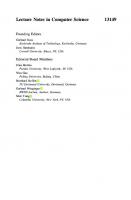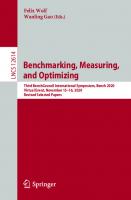From Data to Models and Back: Revised Selected Papers of the 9th International Symposium, DataMod 2020, Virtual Event, October 20, 2020 [1 ed.] 3030706494, 9783030706494
This book constitutes the refereed proceedings of the 9th International Symposium on From Data Models and Back, DataMod
256 54 11MB
English Pages 239 [233] Year 2021
Table of contents :
Preface
Organization
Towards AI-driven Data Analysis and Fabrication (Abstract of Invited Talk)
Contents
Machine Learning
Synthesis and Pruning as a Dynamic Compression Strategy for Efficient Deep Neural Networks
Abstract
1 Introduction
2 Related Work
3 Method
3.1 Approaches
3.2 Procedure
4 Problem Dataset
5 Results
6 Further Considerations
6.1 Residual Networks
6.2 Sub-networks
6.3 False Starts
6.4 Strategic Targets
6.5 Redundancy
6.6 Hybrid Scheduling
7 Conclusions and Future Work
References
Exploring Graph-Based Neural Networks for Automatic Brain Tumor Segmentation
1 Introduction
2 Related Work
2.1 Convolutional Neural Networks
2.2 Graph Neural Networks
2.3 Explanation of Deep Learning Models
3 Methods
3.1 Imaging Data
3.2 Data Preprocessing
3.3 Graph Construction
3.4 GNN Details
3.5 Training and Evaluation Metrics
3.6 Baseline Method
3.7 Model Interpretation
4 Results
4.1 Supervoxel Generation Affects Achievable Accuracy
4.2 Brain Tumor Segmentation Performance of Different GNN Models
4.3 Performance and Runtime Results for Varying Neighborhood Sizes
4.4 Comparison of GNN Model with Other Recent Models
4.5 Explaining GNN Predictions Using SHAP
5 Discussion
References
STDI-Net: Spatial-Temporal Network with Dynamic Interval Mapping for Bike Sharing Demand Prediction
1 Introduction
2 Related Work
3 Preliminaries
4 Proposed Spatial-Temporal Dynamic Interval Network
4.1 Spatial Module
4.2 Temporal Module
4.3 Dynamic Interval Module
4.4 Implementation Details
5 Experiment
5.1 Dataset
5.2 Evaluation Metric
5.3 Baselines
5.4 Comparison with Baselines
5.5 Comparison with Modules Combinations
5.6 Comparison with Variants of Our Model
5.7 Influence of Sequence Length and Number of ResUnits
6 Conclusion and Discussion
References
Simulation-Based Approaches
A Simulation-Based Approach for the Behavioural Analysis of Cancer Pathways
1 Introduction
2 Data Analysis and Queries Development
3 Simulation Modelling and DES
4 Model Validation
5 Simulation Results
6 Conclusion
References
Discovering the Impact of Notifications on Social Network Addiction
1 Introduction
2 The Internet Addiction
2.1 The Network Communication Model
2.2 The Mathematical Model of Dopamine System
3 Dataset
4 Simulations
5 Results
6 Conclusions
References
A Simulation Study on Demand Disruptions and Limited Resources for Healthcare Provision
1 Introduction
2 Southern Brazilian Hospital Settings
2.1 A&E Triage System
2.2 Usual Pre-pandemic A&E Patient Care Process
3 Applied Modelling and Simulation in the A&E
3.1 Input Data Modelling for the Pre-pandemic Simulation
4 Pre-pandemic and Post-pandemic Scenarios Simulation
4.1 Pre-pandemic Scenario Simulation
4.2 A&E Disruption Scenarios During and Post-pandemic
5 Conclusion
References
A Formal Model for Emulating the Generation of Human Knowledge in Semantic Memory
1 Introduction
2 Cognitive Models for Information Transfer
3 Real-Time Maude Models of STM and Semantic Memory
3.1 Facts, Questions and Goals
3.2 Modelling Basic Information Items and Goals
3.3 Modelling Explicit Attention and Goal Achievements
3.4 STM—Short-Term Memory
3.5 Semantic Memory
4 Modelling Memory Processes
4.1 Perception
4.2 Maintenance Rehearsal
4.3 Elaborative Rehearsal
4.4 Transfer from STM to Semantic Memory
5 In Silico Experiments
5.1 Rote Learning
5.2 Effective Learning
6 Conclusion and Future Work
References
Analysis of COVID-19 Data with PRISM: Parameter Estimation and SIR Modelling
1 Introduction
2 SIR Epidemic Models and COVID-19
3 Parameter Estimation
4 Translation into CTMC and Analysis with PRISM
5 Conclusions
References
A Formal Model for the Simulation and Analysis of Early Biofilm Formation
1 Introduction
1.1 Real-Time Maude
2 Biofilm Formation Model
2.1 Real-Time Maude Configuration and Rewrite Rules
2.2 Creation of the Initial Population
2.3 Biofilm Formation
2.4 Cell Reproduction
2.5 Cell Death
2.6 Time Increment
2.7 Intervention to Prevent Biofilm Formation
3 In Silico Experiments and Formal Analysis
3.1 Pseudomonas Aeruginosa
3.2 Simulation
3.3 Formal Analysis Using Model Checking
4 Conclusion and Future Work
References
Data Mining and Processing Related Approaches
Query Rewriting on Path Views Without Integrity Constraints
1 Introduction
2 Related Work
3 Preliminaries
4 Defining Smart Plans
5 Characterizing Smart Plans
5.1 Web Service Functions
5.2 Preliminary Definitions
5.3 Characterising Smart Plans
6 Generating Smart Plans
6.1 Minimal Smart Plans
6.2 Bounding and Generating the Weakly Smart Plans
6.3 Generating the Weakly Smart Plans
7 Experiments
7.1 Synthetic Functions
7.2 Real-World Web Services
8 Conclusion
References
Evaluating Trace Encoding Methods in Process Mining
1 Introduction
2 Related Work
3 Encoding Methods
3.1 Trace Replay and Alignment
3.2 Word Embeddings
3.3 Graph Embeddings
4 Materials and Methods
4.1 Event Logs
4.2 Trace Encoding
4.3 Feature Vector Measures and Classification Algorithm
5 Results and Discussion
5.1 Accuracy Performance
5.2 Time Usage
5.3 Encoding Representativeness
5.4 Encoding Ranking
6 Conclusion
References
Semantic Annotations in Clinical Guidelines
1 Introduction
2 Related Work
3 The Framework
4 Semantic Annotations
4.1 A Hierarchy of Concepts
4.2 Relationship Between Classes
4.3 Named-Entity Recognition
5 Learning
5.1 Syntactic Analysis of Guideline Sentences
5.2 Semantic Analysis of Guideline Sentences
5.3 Features
5.4 Learning Algorithm
5.5 Long Short-Term Memory for NER
6 Evaluation
6.1 Dataset Analysis
6.2 Experiments
7 Conclusion
References
Deriving Performance Measures of Workflow in Radiation Therapy from Real-Time Data
1 Introduction
2 Methods
2.1 Standardised Model of the RTP Workflow
2.2 Real-Time Tracking and Display of RTP Workflow
2.3 Performance Measures of RTP Workflow
3 Results
3.1 Real-Time Tracking and Display of Workflow
3.2 Performance Measures
3.3 Compliance in Recording Task Completion
3.4 Elapsed Time to Task Completion
3.5 On-Time Performance Relative to Ideal Timeline
3.6 Elapsed Time Between Tasks
4 Discussion
References
Handshape Classification in a Reverse Dictionary of Sign Languages for the Deaf
1 Introduction
2 Related Work
2.1 Sign Language Dictionaries
2.2 Sign Language Fingerspelling Recognition
3 System Design and Architecture
3.1 Datasets
3.2 Implementation Details
4 System Functionality
4.1 Search by Handshapes
4.2 Search by Fingerspelling
4.3 Other Search Methods
5 Evaluation
6 Conclusion and Future Work
References
Author Index
Preface
Organization
Towards AI-driven Data Analysis and Fabrication (Abstract of Invited Talk)
Contents
Machine Learning
Synthesis and Pruning as a Dynamic Compression Strategy for Efficient Deep Neural Networks
Abstract
1 Introduction
2 Related Work
3 Method
3.1 Approaches
3.2 Procedure
4 Problem Dataset
5 Results
6 Further Considerations
6.1 Residual Networks
6.2 Sub-networks
6.3 False Starts
6.4 Strategic Targets
6.5 Redundancy
6.6 Hybrid Scheduling
7 Conclusions and Future Work
References
Exploring Graph-Based Neural Networks for Automatic Brain Tumor Segmentation
1 Introduction
2 Related Work
2.1 Convolutional Neural Networks
2.2 Graph Neural Networks
2.3 Explanation of Deep Learning Models
3 Methods
3.1 Imaging Data
3.2 Data Preprocessing
3.3 Graph Construction
3.4 GNN Details
3.5 Training and Evaluation Metrics
3.6 Baseline Method
3.7 Model Interpretation
4 Results
4.1 Supervoxel Generation Affects Achievable Accuracy
4.2 Brain Tumor Segmentation Performance of Different GNN Models
4.3 Performance and Runtime Results for Varying Neighborhood Sizes
4.4 Comparison of GNN Model with Other Recent Models
4.5 Explaining GNN Predictions Using SHAP
5 Discussion
References
STDI-Net: Spatial-Temporal Network with Dynamic Interval Mapping for Bike Sharing Demand Prediction
1 Introduction
2 Related Work
3 Preliminaries
4 Proposed Spatial-Temporal Dynamic Interval Network
4.1 Spatial Module
4.2 Temporal Module
4.3 Dynamic Interval Module
4.4 Implementation Details
5 Experiment
5.1 Dataset
5.2 Evaluation Metric
5.3 Baselines
5.4 Comparison with Baselines
5.5 Comparison with Modules Combinations
5.6 Comparison with Variants of Our Model
5.7 Influence of Sequence Length and Number of ResUnits
6 Conclusion and Discussion
References
Simulation-Based Approaches
A Simulation-Based Approach for the Behavioural Analysis of Cancer Pathways
1 Introduction
2 Data Analysis and Queries Development
3 Simulation Modelling and DES
4 Model Validation
5 Simulation Results
6 Conclusion
References
Discovering the Impact of Notifications on Social Network Addiction
1 Introduction
2 The Internet Addiction
2.1 The Network Communication Model
2.2 The Mathematical Model of Dopamine System
3 Dataset
4 Simulations
5 Results
6 Conclusions
References
A Simulation Study on Demand Disruptions and Limited Resources for Healthcare Provision
1 Introduction
2 Southern Brazilian Hospital Settings
2.1 A&E Triage System
2.2 Usual Pre-pandemic A&E Patient Care Process
3 Applied Modelling and Simulation in the A&E
3.1 Input Data Modelling for the Pre-pandemic Simulation
4 Pre-pandemic and Post-pandemic Scenarios Simulation
4.1 Pre-pandemic Scenario Simulation
4.2 A&E Disruption Scenarios During and Post-pandemic
5 Conclusion
References
A Formal Model for Emulating the Generation of Human Knowledge in Semantic Memory
1 Introduction
2 Cognitive Models for Information Transfer
3 Real-Time Maude Models of STM and Semantic Memory
3.1 Facts, Questions and Goals
3.2 Modelling Basic Information Items and Goals
3.3 Modelling Explicit Attention and Goal Achievements
3.4 STM—Short-Term Memory
3.5 Semantic Memory
4 Modelling Memory Processes
4.1 Perception
4.2 Maintenance Rehearsal
4.3 Elaborative Rehearsal
4.4 Transfer from STM to Semantic Memory
5 In Silico Experiments
5.1 Rote Learning
5.2 Effective Learning
6 Conclusion and Future Work
References
Analysis of COVID-19 Data with PRISM: Parameter Estimation and SIR Modelling
1 Introduction
2 SIR Epidemic Models and COVID-19
3 Parameter Estimation
4 Translation into CTMC and Analysis with PRISM
5 Conclusions
References
A Formal Model for the Simulation and Analysis of Early Biofilm Formation
1 Introduction
1.1 Real-Time Maude
2 Biofilm Formation Model
2.1 Real-Time Maude Configuration and Rewrite Rules
2.2 Creation of the Initial Population
2.3 Biofilm Formation
2.4 Cell Reproduction
2.5 Cell Death
2.6 Time Increment
2.7 Intervention to Prevent Biofilm Formation
3 In Silico Experiments and Formal Analysis
3.1 Pseudomonas Aeruginosa
3.2 Simulation
3.3 Formal Analysis Using Model Checking
4 Conclusion and Future Work
References
Data Mining and Processing Related Approaches
Query Rewriting on Path Views Without Integrity Constraints
1 Introduction
2 Related Work
3 Preliminaries
4 Defining Smart Plans
5 Characterizing Smart Plans
5.1 Web Service Functions
5.2 Preliminary Definitions
5.3 Characterising Smart Plans
6 Generating Smart Plans
6.1 Minimal Smart Plans
6.2 Bounding and Generating the Weakly Smart Plans
6.3 Generating the Weakly Smart Plans
7 Experiments
7.1 Synthetic Functions
7.2 Real-World Web Services
8 Conclusion
References
Evaluating Trace Encoding Methods in Process Mining
1 Introduction
2 Related Work
3 Encoding Methods
3.1 Trace Replay and Alignment
3.2 Word Embeddings
3.3 Graph Embeddings
4 Materials and Methods
4.1 Event Logs
4.2 Trace Encoding
4.3 Feature Vector Measures and Classification Algorithm
5 Results and Discussion
5.1 Accuracy Performance
5.2 Time Usage
5.3 Encoding Representativeness
5.4 Encoding Ranking
6 Conclusion
References
Semantic Annotations in Clinical Guidelines
1 Introduction
2 Related Work
3 The Framework
4 Semantic Annotations
4.1 A Hierarchy of Concepts
4.2 Relationship Between Classes
4.3 Named-Entity Recognition
5 Learning
5.1 Syntactic Analysis of Guideline Sentences
5.2 Semantic Analysis of Guideline Sentences
5.3 Features
5.4 Learning Algorithm
5.5 Long Short-Term Memory for NER
6 Evaluation
6.1 Dataset Analysis
6.2 Experiments
7 Conclusion
References
Deriving Performance Measures of Workflow in Radiation Therapy from Real-Time Data
1 Introduction
2 Methods
2.1 Standardised Model of the RTP Workflow
2.2 Real-Time Tracking and Display of RTP Workflow
2.3 Performance Measures of RTP Workflow
3 Results
3.1 Real-Time Tracking and Display of Workflow
3.2 Performance Measures
3.3 Compliance in Recording Task Completion
3.4 Elapsed Time to Task Completion
3.5 On-Time Performance Relative to Ideal Timeline
3.6 Elapsed Time Between Tasks
4 Discussion
References
Handshape Classification in a Reverse Dictionary of Sign Languages for the Deaf
1 Introduction
2 Related Work
2.1 Sign Language Dictionaries
2.2 Sign Language Fingerspelling Recognition
3 System Design and Architecture
3.1 Datasets
3.2 Implementation Details
4 System Functionality
4.1 Search by Handshapes
4.2 Search by Fingerspelling
4.3 Other Search Methods
5 Evaluation
6 Conclusion and Future Work
References
Author Index
![From Data to Models and Back: Revised Selected Papers of the 9th International Symposium, DataMod 2020, Virtual Event, October 20, 2020 [1 ed.]
3030706494, 9783030706494](https://ebin.pub/img/200x200/from-data-to-models-and-back-revised-selected-papers-of-the-9th-international-symposium-datamod-2020-virtual-event-october-20-2020-1nbsped-3030706494-9783030706494.jpg)
- Author / Uploaded
- Juliana Bowles
- Giovanna Broccia
- Mirco Nanni

![Rewriting Logic and Its Applications: 13th International Workshop, WRLA 2020, Virtual Event, October 20-22, 2020, Revised Selected Papers [1st ed.]
9783030635947, 9783030635954](https://ebin.pub/img/200x200/rewriting-logic-and-its-applications-13th-international-workshop-wrla-2020-virtual-event-october-20-22-2020-revised-selected-papers-1st-ed-9783030635947-9783030635954.jpg)




![Static Analysis: 27th International Symposium, SAS 2020, Virtual Event, November 18–20, 2020, Proceedings [1st ed. 2020]
3030654737, 9783030654733](https://ebin.pub/img/200x200/static-analysis-27th-international-symposium-sas-2020-virtual-event-november-1820-2020-proceedings-1st-ed-2020-3030654737-9783030654733.jpg)

